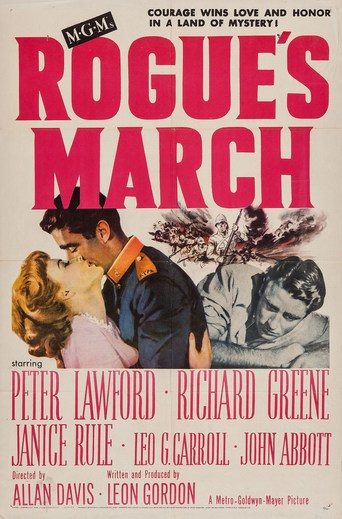zardoz-13
The last film on Peter Lawford's contract at Metro-Goldwyn-Mayer, director Allan Davis' "Rogue's March" amounts to a lightweight rehash of Zoltan Korda's classic "The Four Feathers" (1939) with John Clements. Despite an end credits thanks to India for allowing MGM to lense scenes in the Khyber Pass, most of this black & white epic was shot at the studio and at Vasquez Rocks in Southern California. Only the grain on the film betrays the fact that footage from the Errol Flynn adventure film "Kim" (1950) was used. A stellar cast, including Richard Greene, Janice Rule, Leo G. Carroll, Michael Pate, Sean McClory, Hayden Rorke, John Lupton, and Sidney Lawford, surround Peter Lawford. Mind you, it is routine from fade in to fadeout, but this 84-minute escapade depicts the court-martial of Captain Dion Lenbridge (Peter Lawford of "Sergeants 3") just as the Royal Midlands Fusiliers has been ordered to leave for action on the Afghan-Indian border. The military convict Lenbridge of selling secrets to the Russians, strip him of his rank, boot him out of the army, and prepare to try him in civil court. Lenbridge gives his minders the slip and re-enlists in another regiment. All of this comes at a particularly distressful time because Lenbridge had proposed marriage to Jane Wensley (Janice Rule of "Alvarez Kelly"). Although it qualifies as a potboiler, "Rogue's March" is a tolerably entertaining endeavor with a crisp Peter Lawford performance. Too bad it wasn't shot in color to take advantage of all those beautiful British uniforms.
RanchoTuVu
After an officer is drummed out of one of the brigades of the British empire for being accused of and then convicted of selling secrets to Russian agents, he joins a different brigade and eventually winds up having to deal with his accusers and the real culprits, everything being shifted from London to a remote part of India where an insurgency is being stoked by the Russians. The similarity to what is happening today in Afghanistan makes this rather intriguing, though the best parts occur in London before the action shifts to India. Peter Lawford was an original Rat Pack member (with Dean Martin, Frank Sinatra, Sammy Davis Jr., etc..), and even if this film is pre Rat Pack, with this film you can see why he'd later fit in so well in Las Vegas. Even as he's being officially kicked out of his elite brigade in front of all the assembled ranks, which is one of the films better parts, he still looks like he could care less. On the lam in London for escaping from the civilian police, he gets a job as a bartender in a rundown section of town and listens in on and then butts into a conversation as a sergeant is busy trying to pick up on a supposedly loose woman. Lawford's character is socially above them, but due to the circumstances he's now at the bottom of the social ladder in civilian society. When he joins another regiment he comes in as a private, yet through it all this guy has undeniable class and a saving sense of humor. The film itself isn't half bad, as Lawford's character finds out who actually did sell those military secrets. His character's eventual reinstatement into his rightful place in the military and society is a foregone conclusion. The battle scenes are filmed on location (in Southern California?), and aren't that impressive. What's more impressive is what the Russians do to the real culprit in another scene which is the most intense in a film that lacks, for the most part, intensity.
theowinthrop
There is a minor genre connected to war films of "proving" or "redeeming" films: Where the hero is branded coward or traitor and has to try to show he's been wronged. The best examples of these are the original FOUR FEATHERS (1939) and THE LIFE OF EMILE ZOLA (1938)[about the Dreyfus Case]. ROUGUES MARCH (1953) is a poor cousin of the other films, as it chronicles Peter Lawford's attempts to show he was framed for treason in India. The best moment in the film is when the actual traitor (John Abbott) is drowned by his Russian agent associates. The climax is when Lawford, after he has gotten his proof and presents it to his commanding officer is informed by that officer that the British Army knew the charges were false to begin with. That gives you a pretty good idea of the value of this film. Oh, as the commanding officer is Leo G. Carroll, perhaps you can see his performance here as a preperation for his U.S. spymaster handling Cary Grant in NORTH BY NORTHWEST (1959).
reve-2
This unusual film stars a young and dapper Peter Lawford. As I started to watch the film I doubted that I would like it because I have never been a big Lawford fan. But, to my pleasant surprise, the combination of an interesting story line and an exceptional performance by Lawford made it a most enjoyable experience for me. The plot has Lawford, a British officer, framed as a traitor who has sold military secrets to the Russians who are backing insurgents in India. He is ceremoniously publicly humiliated and drummed out of the service. After that he is scheduled to go on trial in a civil court but he escapes and gets back into the service by using a fake name. He spends the remainder of the film trying to get back his good name and see that justice is done. There are excellent battlefield scenes in this film. I think that you will enjoy this "sleeper" of a movie.


